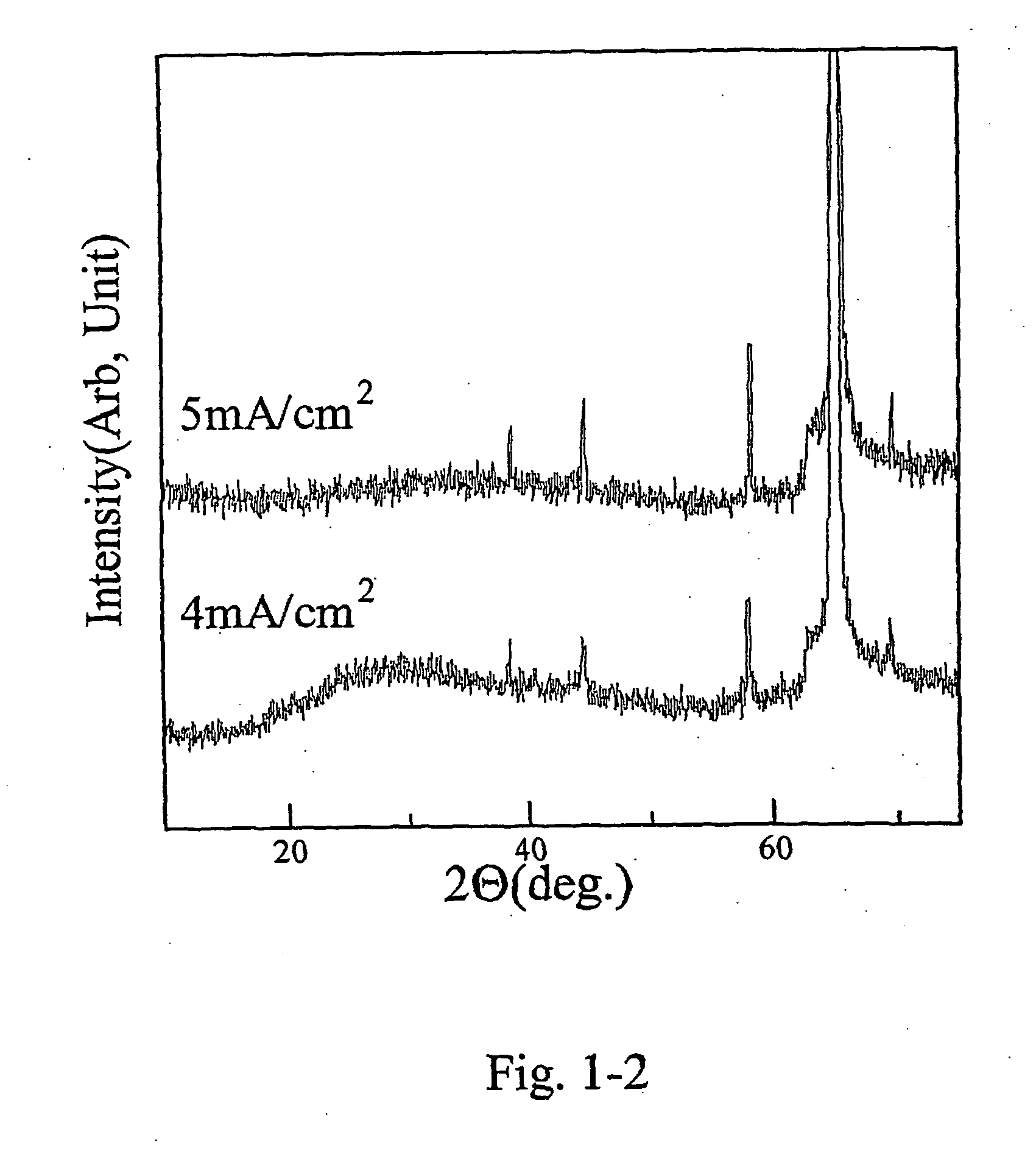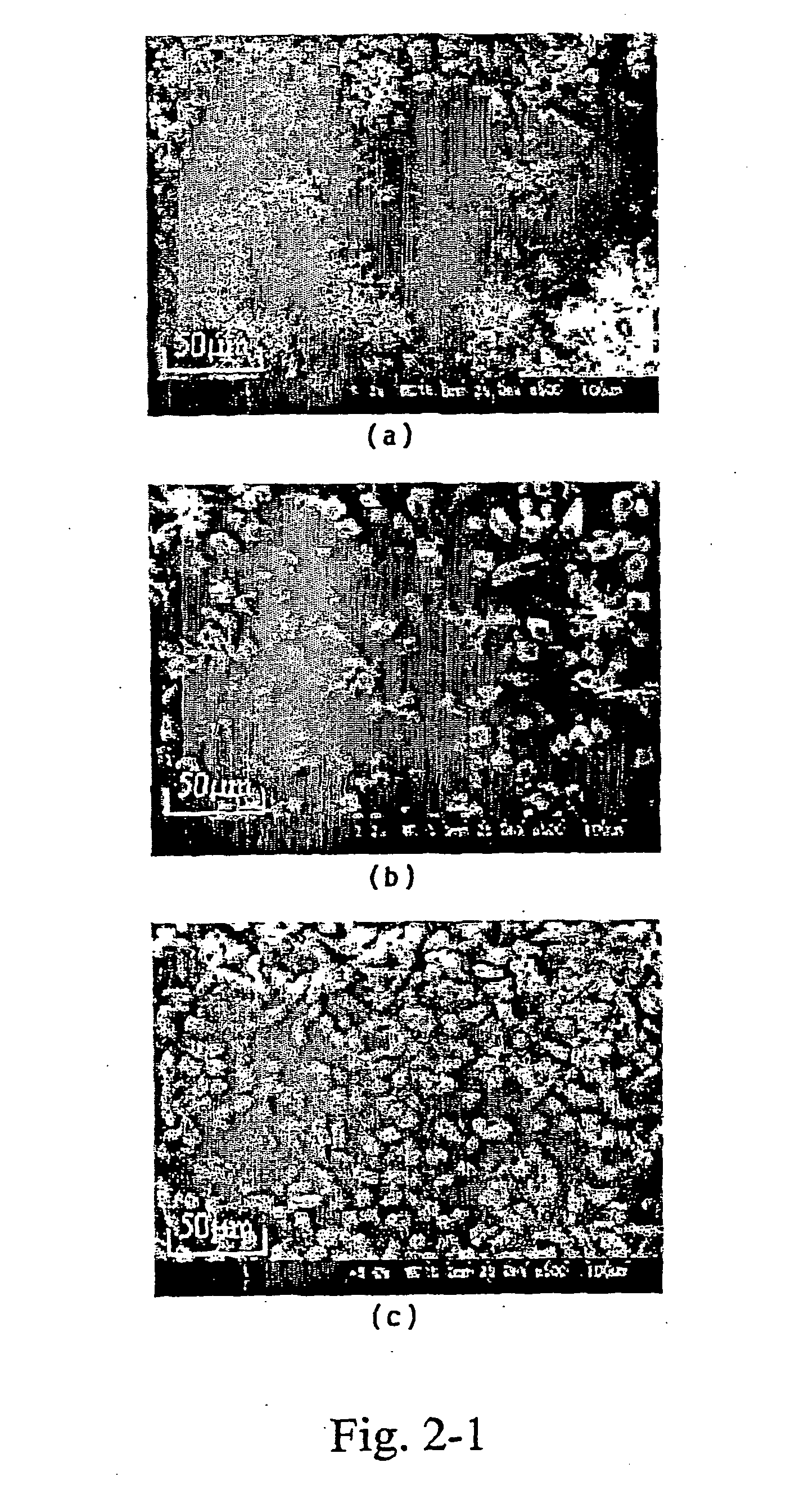Corrosion-protection by electrochemical deposition of metal oxide layers on metal substrates
a metal substrate and electrochemical technology, applied in electrophoretic coatings, coatings, chemistry apparatuses and processes, etc., can solve the problems of sludge containing heavy metals, chromating process disadvantages, and difficult to achieve the effect of preventing sludge from forming,
- Summary
- Abstract
- Description
- Claims
- Application Information
AI Technical Summary
Benefits of technology
Problems solved by technology
Method used
Image
Examples
example 1
Example 1-1
[0094] TiO2-layers were electrochemically grown from titanyl sulfate aqueous solution with sodium nitrate and sodium tartrate at cathodic potentials of −0.8 V, −1.0 V and −1.2 V, respectively. Titanyl sulfate concentration was 0.1 mol / L. Sodium tartrate concentration was 0.1 mol / L. Sodium nitrate concentration was 0.1 mol / L. A titanium sheet (99.999% purity) was used as an active anode. An Ag / AgCl-electrode was used as a reference. Electrolysis was carried out potentiostatically using a potentio / galvanostat (Hokuto Denko, HABF501) without stirring. Table 1-1 shows the electrochemical deposition conditions for the TiO2-layers of Example 1-1.
TABLE 1-1Electrochemical growth conditionsfor the TiO2-layers of Example 1-1Composition of the electrolyteTitanyl sulfate concentration0.1 mol / LSodium tartrate concentration0.1 mol / LSodium nitrate concentration0.1 mol / LAnode electrodetitanium sheet (99.999%)Substrate (cathodic electrode)NESA-glassReferring electrodeAg / AgClpH for the ...
example 1-2
[0095] On aluminum sheet, TiO2-layers were electrochemically grown by using the electrolyte and the equipment mentioned above. A titanium sheet (99.999%) was used as the active anode, and an Ag / AgCl-electrode was used as a reference. Electrolysis was performed by using potentio / galvanostat (Hokuto Denko, HABF501) without stirring at −4 mA / cm2 and −5 mA / cm2 cathodic current density. The Coulomb values were constant values of 10 C / cm2, regardless of all electrochemical growth conditions. Table 1-2 shows the electrochemical deposition conditions for the TiO2-layers of Example 1-2. FIG. 1-2 shows the X-ray diffraction spectra of the TiO2-layers off Example 1-2 galvanostatically obtained. All diffraction lines were identified to those of TiO2.
TABLE 1-2Electrochemical growth conditionsfor the TiO2-layers of Example 1-2Composition of electrolyteTitanyl sulfate concentration0.1 mol / LSodium tartrate concentration0.1 mol / LSodium nitrate concentration0.1 mol / LAnode electrodetitanium sheet (9...
example 2
[0096] In Example 2, polycrystalline TiO2-layers were electrochemically grown on NESA-glass substrates from a 0.05 M titanium potassium oxalate dihydrate aqueous solution containing a 0.5 M hydroxylamine at 333 K by cathodic potentiostatic methods. The electrolytes were adjusted to pH=9 with KOH (aq.). A titanium sheet (99.999%) was used as active anode, and an Ag / AgCl-electrode was used as a reference. Electrolysis was performed by using potentiostatic / galvanostatic (Hokuto Denko, HABF501) without stirring at cathodic potential range of −1.3 V to −1.0 V. The Coulomb values were constant values of 10 C / cm2, regardless of all electrochemical growth conditions. Table 2-1 shows the electrochemical deposition conditions for the TiO2-layer of Example 2.
TABLE 2-1Electrochemical growth conditionsfor the TiO2-layers of Example 2Composition of electrolyteTitanium potassium oxalate0.05 mol / Ldihydrate concentrationHydroxylamine concentration 0.5 mol / LAnode electrodetitanium sheet (99.999%)Su...
PUM
| Property | Measurement | Unit |
|---|---|---|
| Temperature | aaaaa | aaaaa |
| Temperature | aaaaa | aaaaa |
| Temperature | aaaaa | aaaaa |
Abstract
Description
Claims
Application Information
 Login to View More
Login to View More - R&D Engineer
- R&D Manager
- IP Professional
- Industry Leading Data Capabilities
- Powerful AI technology
- Patent DNA Extraction
Browse by: Latest US Patents, China's latest patents, Technical Efficacy Thesaurus, Application Domain, Technology Topic, Popular Technical Reports.
© 2024 PatSnap. All rights reserved.Legal|Privacy policy|Modern Slavery Act Transparency Statement|Sitemap|About US| Contact US: help@patsnap.com










